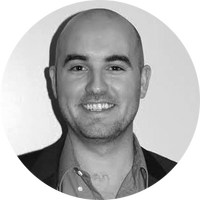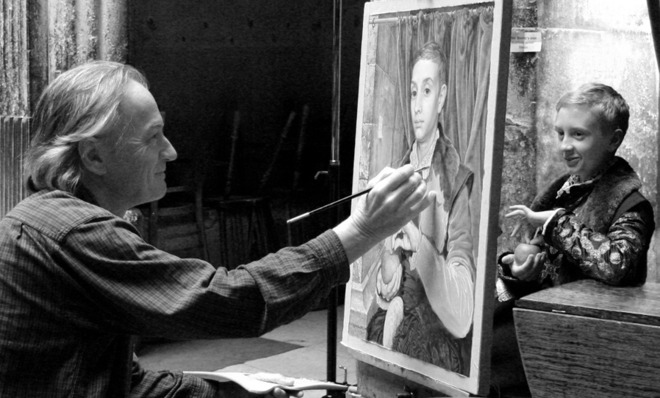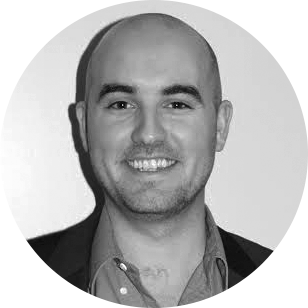The untold story behind The Grand Budapest Hotel's 'Boy with Apple'
The painting may not actually be centuries old — but it certainly has a history


The plot of Wes Anderson's The Grand Budapest Hotel hinges on a single, much-discussed painting: "Boy with Apple," a Renaissance masterpiece by the artist Johannes Van Hoytl the Younger. ("The rest of his shit is worthless junk," confides Ralph Fiennes' Gustave H.)
In reality, "Boy with Apple" isn't a centuries-old masterpiece by a Czech painter. It was created just two years ago by the acclaimed English painter Michael Taylor. Fortunately, the real-life origin story of "Boy with Apple" is just as interesting as the one presented in The Grand Budapest Hotel.
To get the full story on "Boy with Apple," The Week reached out to Michael Taylor and Ed Munro, the boy who served as the model for the painting. Their combined recollections offer a complete portrait of one of the most memorable MacGuffins in recent movie history.
The Week
Escape your echo chamber. Get the facts behind the news, plus analysis from multiple perspectives.

Sign up for The Week's Free Newsletters
From our morning news briefing to a weekly Good News Newsletter, get the best of The Week delivered directly to your inbox.
From our morning news briefing to a weekly Good News Newsletter, get the best of The Week delivered directly to your inbox.
………………………………………………………………………………
Michael Taylor: I was initially contacted by one of the film's producers. [Director Wes Anderson] called me up, and we talked a bit before he sent me a script with a very eclectic collection of images: castles, old postcards of eastern European hotels, an alpine observatory — and of course, lots of Renaissance portraits of boys and young men. I was intrigued, and I thought, "Why not?"
Ed Munro: On weekends, I dance at Pineapple Dance Studios in Covent Garden, London. We heard that a film director was looking for a blonde-haired boy with a ballet dancer's figure. We weren't told the name of the director, or anything at all about the film. I sent some photos to the casting agent, and the next day I heard that the director had liked the pictures, and that I had the job. All I was told was that I was going to sit for a portrait, which would be used as a "hero prop" in a film.
Michael: [Anderson provided] a lot of input — particularly paintings by Bronzino, Holbein, Cranach; all sorts of stuff. I'd send suggestions and he would say, "Yes, yes, we must have that," or "Why not some other color sleeve?" and so on. Some of it was very specific, but sometimes it was pretty broad, even contradictory — until I realized that maybe he wanted something that felt like it might have existed, but in some slightly parallel place.
A free daily email with the biggest news stories of the day – and the best features from TheWeek.com
Ed: I tried on every combination of velvet cloaks, furs, bodices, tights, shoes, codpieces...probably about 50 combinations. One of the bodices had been worn by Cate Blanchett when she played Elizabeth I. The dresser took photos of every outfit. They were sent to Wes Anderson, and he decided the final costume.
Michael: I wasn't familiar with Wes Anderson's films [when I was hired to paint "Boy with Apple"] — but now that I come to think about it, that gave me the advantage of a "clean palette," so to speak. I think familiarity with his aesthetic could have been very contagious, and I feel the painting benefits from having its own identity.

Michael: Ed and I got along fine, and he looked perfect for the part. He stayed with us in Dorset.
Ed: There is an amazing old school near [Michael's] house — it's Jacobean, with a beautiful stone courtyard, and it had just the right atmosphere. It's a girls' boarding school — but it was during the summer holidays, so it was deserted, apart from some horses in the stables and the headmistress. It was really spooky to wander through the dormitories and the huge kitchens and gardens. Michael would put Elizabethan music on his CD player to get the mood just right.
Michael: The position of the hands is quite a difficult pose, so it must have been hard work for Ed.
Ed: The costume was uncomfortable, and it was difficult to hold the same expression for hours. My hands ached from holding the apple in the same position. I wasn't allowed to chew gum or check my phone. We had plenty of breaks, though, for tea and biscuits.
Michael: [Anderson] left me pretty much alone to do my own thing for a couple of months, but as filming got nearer he asked to see "Boy with Apple." Some of it was right, but other aspects didn't fit his idea at all, so we began to work on it together, bouncing it back and forth by email. I had [The Grand Budapest Hotel] script, but I tried not to think about it too much. Being asked to invent something priceless can be a bit of a pressure — but of course, ["Boy with Apple"] does spend a lot of time wrapped up in brown paper.

Michael: On and off, [completing "Boy with Apple"] took almost four months, from start to delivery.
Ed: I was really pleased when the producer sent me a link to the trailer and I saw what a big part the painting played in the film. […] When I first saw ["Boy with Apple"] almost two years ago, I didn't think it looked like me. It's strange, because it looks more like me now that I'm older.
Michael: I think we ended up with something that had a bit of me, and a bit of [Anderson] in it. It kind of looks familiar — but isn't quite like anything else either.

Ed: Wes Anderson invited me and my parents to the Paris premiere of the film. We woke up on the morning of the premiere, and the whole of Paris was filled with the pink Grand Budapest Hotel posters. [After I saw it] I wanted to see it again straight away. I loved everything about it. I've seen it four times.
Michael: I went to a screening and thoroughly enjoyed it. I felt like I'd spent 90 minutes inside a tightly wound clockwork toy — but there is a darkness and underlying melancholy seeping through the gaps in the machinery which give it a gravity. I felt very proud to have contributed something to it.
Ed: [I don't know where the original painting is], but there's a "Boy with Apple" phone case that my mum wants for Mother's Day. I guess having a copy of the DVD when [The Grand Budapest Hotel] comes out will be the best thing.
Michael: [The original "Boy with Apple"] could be anywhere. One of the charms of making paintings is that you create this thing, and then send it out into the world where it has to make its own way. I constructed a nice padded box to protect it from the rough and tumble of life on set, with "How to Care for Your Boy with Apple" instructions pasted in the lid — and that was the last I saw of it until I watched The Grand Budapest Hotel.
Scott Meslow is the entertainment editor for TheWeek.com. He has written about film and television at publications including The Atlantic, POLITICO Magazine, and Vulture.
-
 Venezuela’s Trump-shaped power vacuum
Venezuela’s Trump-shaped power vacuumIN THE SPOTLIGHT The American abduction of Venezuelan President Nicolás Maduro has thrust South America’s biggest oil-producing state into uncharted geopolitical waters
-
 Most data centers are being built in the wrong climate
Most data centers are being built in the wrong climateThe explainer Data centers require substantial water and energy. But certain locations are more strained than others, mainly due to rising temperatures.
-
 ‘Maps are the ideal metaphor for our models of what the world might be’
‘Maps are the ideal metaphor for our models of what the world might be’Instant Opinion Opinion, comment and editorials of the day
